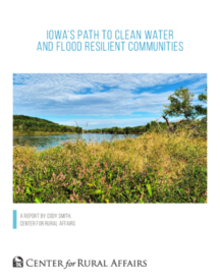As Iowans, water is central to each of our most basic activities, and, in our state, there is a lot of it. Across Iowa, there are 416 square miles of surface water, which 3,155,070 residents rely on for recreation, drinking water, agriculture, or other purposes. At the same time, Iowa ranks second in the U.S. for total agricultural production with $27,535,876 in total cash receipts from all commodities. Simultaneously, as a result of human-induced climate change, total precipitation has increased by three inches over the last three decades in the state. On its own, ranking first in the nation for corn, egg, and hog production on the state’s 30,622,731 acres of farmland is an impressive feat. Conversely, in totality, this mixture of agricultural superiority and an increasingly wet climate can spell trouble for the management of Iowa’s water resources, especially as it relates to water quality and flood mitigation.
At all levels of government, there are opportunities to provide leadership in the management of water resources. Local governments can develop watershed management plans to guide action, collaboration, and success by coordinating with city, county, and other public entities to achieve water quality and flood reduction targets. State leaders can, and do, support programs and initiatives to respond to, prepare for, and improve the management of water resources. Meanwhile, resources from the federal government can help amplify local and state efforts. However, greater strategy and emphasis on local involvement can provide a clear path to improved water quality and enhanced flood mitigation throughout Iowa’s communities.
In June 2020, the Center for Rural Affairs conducted the “Our Iowa, Our Water Survey” to collect views of rural residents on the topics of flooding and water quality in the state and within their communities. The survey was mailed to 1,268 Iowans throughout the state’s most rural state house districts. In addition, it was posted online and promoted to farmers, landowners, small business owners, and many others throughout rural Iowa. In total, the survey received 386 responses, including 143 from farmers or landowners, 23 from local elected officials, and 44 from small business employees or owners. The results have been summarized and will be featured throughout this paper.
Policy


